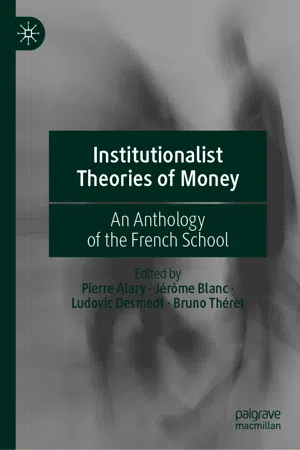For a long time, books were the medium of diffusion favoured by researchers seeking to expound their approaches and their findings. The book format enabled authors to unfold their ideas gradually, to debate the arguments advanced by their contemporaries and to situate themselves precisely relative to their predecessors. Nowadays, greater value is attached in social science research (and especially in economics) to the publication of articles, a format that discourages the production of original work that strays far off the beaten track.1
In the years between 1970 and 1980, edited books played a structuring role in the social sciences. They offered the public and scholars in the same or other disciplines access to specialised research. As far as investigations into questions related to money were concerned, the early 1980s saw an abundance of publishing activity in French, with a whole series of outstanding books being produced, including Marchands, salariat et capitalistes (Benetti and Cartelier 1980), La Violence de la monnaie (Aglietta and Orléan 1982, 2nd edition 1984), Nomismata. État et origine de la monnaie (Servet 1984) and Monnaie privée et pouvoir des princes, L’Économie des relations monétaires à la Renaissance (Boyer-Xambeu et al. 1986: Private Money and Public Currencies: The 16th Century Challenge).2
This initial wave of studies of money sparked off debates that resulted, from 1993 onwards, in a series of seminars that in turn gave rise to a new series of books: Souveraineté, légitimité, confiance (Aglietta and Orléan (eds) 1995), La Monnaie souveraine (Aglietta and Orléan (eds) 1998), La Monnaie dévoilée par ses crises (Théret (ed.) 2007) and La Monnaie contre l’État? La souveraineté monétaire en question (Cuillerai and Théret (eds) forthcoming). These books contain contributions by scholars from various disciplines. Some draw heavily on the insights of history, while others accord a pivotal role to anthropology or philosophy or even to all these disciplines, albeit to varying degrees. Strengthened by all these methods and perspectives drawn from various disciplines, they posed some fundamental questions about money while establishing a common, institutionalist approach—henceforth the institutionalist theory of money (ITM). Money is an institution, a higher order social relation whose complexity cannot be fully captured by a single-disciplinary approach.
In other words, in order to understand money, the economists behind the first wave of books challenged the paradigmatic base of the dominant school of economic thought. They rejected the instrumental approach to money based on the barter myth and linking the analysis of money as an object to that of money as an institution. Some of these authors were to seek out avenues to be explored in other social sciences in order to analyse the genesis (a matter of history for some, a matter of logic for others) and roles of money from a broader perspective.
In order to identify the fundamental questions raised by ITM, this introductory chapter will outline the seven texts that constitute the anthology. It focuses initially on the double objective that preoccupied their authors as they sought to construct an institutionalist theory of money in economics on the basis of heterodox principles while at the same time enriching their research with the conceptual advances being made in the humanities and social sciences, since the phenomenon of money extends well beyond the economic sphere. Attention then turns to the evolution of the theoretical constructs in the successive series of books. The Girardian ‘violence’ of the early studies gives way to the life debt, to ‘sovereignty’ and to ‘trust’. In the third section, the approach’s institutionalism is situated within a broader intellectual environment; the focus here is on the movement’s influence, both within economics and more widely. Finally, the eight chapters are briefly summarised in order to bring out their key ideas.
A Dual Movement
To return to the publications in the first wave of studies (those by Jean Cartelier and Carlo Benetti, Michel Aglietta and André Orléan, Jean-Michel Servet, and Marie-Thérèse Boyer-Xambeu, Ghislain Deleplace and Lucien Gillard), a dual movement can be observed: on the one hand, the statement of the importance of ‘heterodoxy’ within the economic sphere and, on the other, the openness of economics to other disciplines in order to capture the nature of the phenomenon of money and its importance in contemporary societies.
On the first point, contrary to what most neoclassical economists assume, money is not a simple object that enables transactions to be carried out efficiently. Money is not neutral: its creation, diffusion and possession create tensions that spill out beyond the world of economic exchanges. The authors in this first wave refer frequently to the writings of Marx and Keynes, key points of reference for those who advocate a monetary analysis of economic relations.3 True, the compatibility between the labour theory of value and the monetary approach to economics is a problematic issue (cf. in particular Benetti 1985; Cartelier 1985; Orléan 2011), even though Marx emphasises the essential nature of money.4 On this point, there is agreement between Marx and Keynes, whose Treatise on Money, published in 1930 (and not translated into French until 2019!), had a significant influence on adherents of the monetary approach.5
To these theoretical strands we should add the specifically French influence of the writings of Suzanne de Brunhoff and Bernard Schmitt. The former developed a Marxist approach to money,6 the latter extended a number of Keynesian insights.7 These two authors were intensively active during the 1960s and 1970s,8 at the very time when economic theory in the English-speaking world was developing a new understanding of monetary issues. The publications of Don Patinkin (on the problem of integrating money into Walras’s body of work) and subsequently—and most especially—of Milton Friedman certainly provoked critical reactions on their part (Brunhoff 1982). Similarly, the publication of Friedrich Hayek’s work on the denationalisation of money (1976) and extended competition cont...
